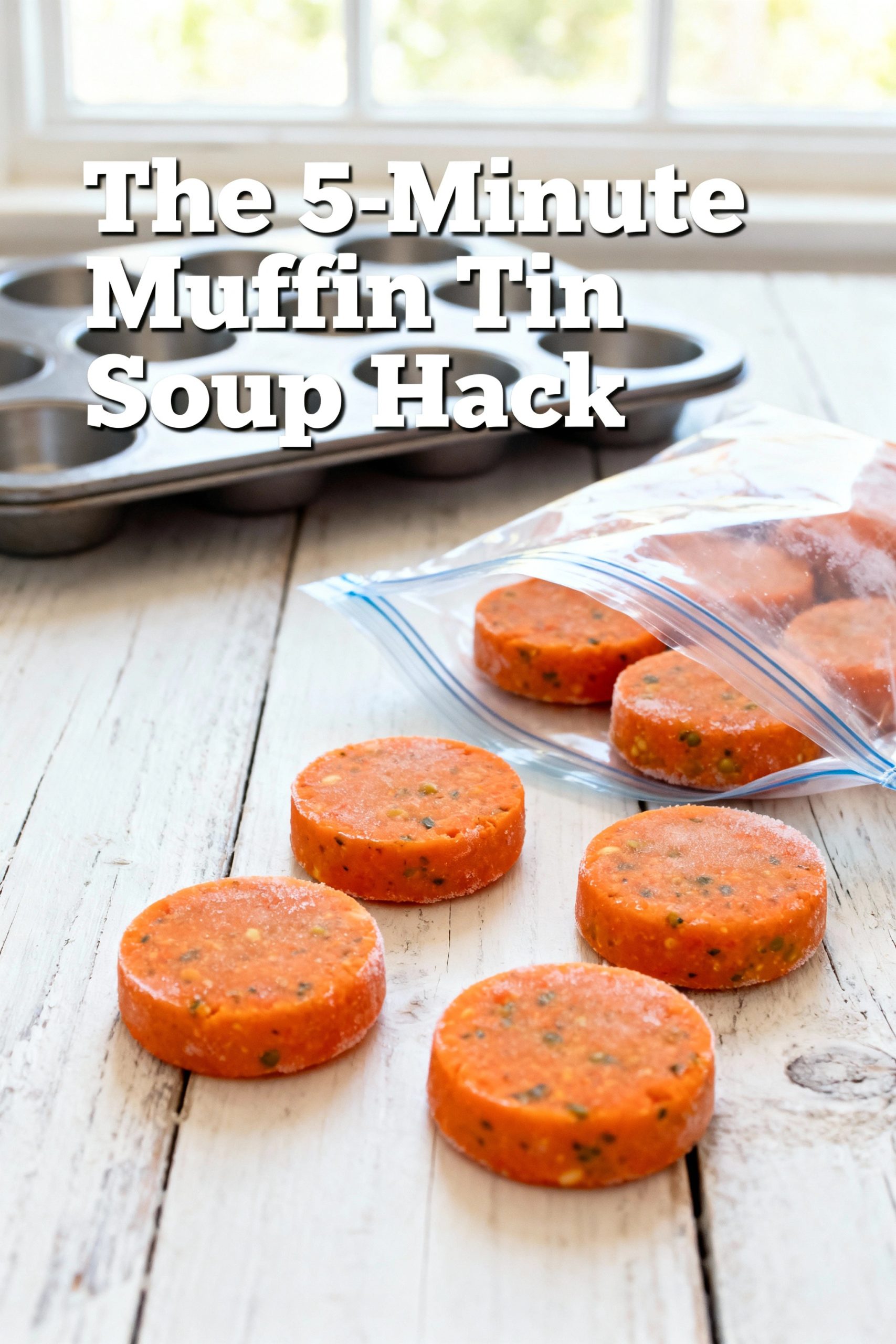Imagine this: you’ve spent time preparing a large, comforting pot of your favorite soup. It’s delicious and nourishing, but after a couple of meals, you’re left with a significant amount of leftovers. The usual solution? Pouring it into a large, bulky container that gets shoved to the back of the freezer, only to be forgotten. When you finally remember it, you’re faced with defrosting a giant, icy block just for a single serving.
There is a much smarter, more efficient way. Today, we’re diving into a brilliantly simple kitchen technique that will fundamentally change how you handle leftover soup: the muffin tin hack.
This method is all about freezing your soup in perfectly uniform, single-serving “pucks.” It’s a game-changer for meal prep enthusiasts, busy individuals, and anyone looking to make their kitchen more organized and less wasteful. Let’s explore how this 5-minute process can streamline your routine.
The Core Benefits: Why This Method is a Must-Try
Using a muffin tin to freeze soup isn’t just a clever trick; it’s a strategic approach to food storage that offers tangible advantages.
Achieve Flawless Portion Control
A standard muffin tin well holds approximately ½ cup (or 4 oz/120 ml) of liquid. This consistency is the foundation of smart portioning. Need a light lunch? Grab two pucks. A small appetizer before dinner? One is perfect. Packing a kid’s thermos for school? One puck is often just the right amount. This eliminates the guesswork and helps you manage your meals with precision.
Drastically Reduce Thawing Time
The single biggest drawback of freezing a large container of soup is the thawing time. A large block can take hours to defrost in the fridge or require lengthy, uneven heating in the microwave. Small, individual pucks, however, can be reheated from frozen in just a few minutes on the stovetop or in the microwave, taking you from freezer to a warm bowl of soup in record time.
Maximize Your Freezer Space
Bulky, awkwardly shaped containers are the enemy of an organized freezer. These frozen soup pucks, once removed from the tin, can be stored neatly in a single freezer-safe bag or a stackable container. They lie flat and take up a fraction of the space, allowing you to store more food in a much more orderly fashion. It’s like playing Tetris with your food, and you’ll always win.
Your Step-by-Step Guide to Freezing Soup Like a Pro
Ready to master the technique? It’s as easy as it sounds.
What You’ll Need:
- Leftover soup, cooled to room temperature
- A standard metal or silicone muffin tin
- A ladle
- A freezer-safe bag or airtight container
- A permanent marker for labeling
The Process:
- Cool it Down Completely: This is the most important step for quality and safety. Pouring hot liquid into a cold environment can cause freezer burn, affect the soup’s texture, and even damage your muffin tin. Allow your soup to cool on the counter until it’s at least room temperature.
- Ladle with Care: Place your muffin tin on a small baking sheet for stability—this prevents spills as you move it to the freezer. Carefully ladle the cooled soup into each well. Try to fill them evenly, leaving a tiny bit of space at the top for the liquid to expand as it freezes.
- Freeze Until Solid: Carefully place the baking sheet with the muffin tin on a flat, level surface in your freezer. Let it freeze for a minimum of 4-6 hours, or overnight, until the soup pucks are frozen completely solid.
- Release and Store: Once solid, remove the tin from the freezer. If you’re using a silicone tin, the pucks should pop out easily. For a metal tin, you might need to let it sit on the counter for a minute or two, or run the bottom of the tin under warm (not hot) water for a few seconds to loosen them.
- Label for Future You: Immediately transfer the frozen pucks into your freezer bag or container. Squeeze out as much air as possible before sealing. Using a permanent marker, label the bag with the type of soup and the date. Your future self will thank you! Frozen soup pucks maintain their best quality for up to 3 months.
Reheating Your Portions: Two Easy Methods
When you’re ready for a warm meal, simply grab the number of pucks you need.
- Stovetop Method: Place the frozen pucks in a small saucepan over medium-low heat. As they begin to melt, stir occasionally until the soup is simmering and heated through.
- Microwave Method: Place the pucks in a microwave-safe bowl. Heat in 1-minute intervals, stirring in between, until the soup is hot.
Best Soups for This Method (And a Few to Be Cautious With)
While this technique is versatile, some soups freeze better than others.
Excellent Candidates:
- Puréed Soups (Tomato, Butternut Squash, Pumpkin)
- Broth-Based Soups (Chicken Noodle – without the noodles, Vegetable)
- Lentil and Bean Soups
- Chilis and Stews
Use with Caution:
- Cream- or Dairy-Based Soups: Dairy can sometimes separate upon thawing, resulting in a grainy texture. They can often be revived by whisking vigorously while reheating, but the texture may not be identical.
- Soups with Pasta or Rice: These starches tend to absorb a lot of liquid and can become very soft or mushy after being frozen and reheated. It’s often better to freeze the soup base and add freshly cooked pasta or rice when you serve.
- Potato-Based Soups: Potatoes can sometimes become mealy or grainy in the freezer.
This simple, effective muffin tin approach is more than just a hack—it’s a system for a more intentional and resourceful kitchen. Give it a try, and enjoy the convenience of having a perfect portion of homemade soup ready whenever you need it.



